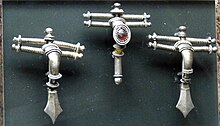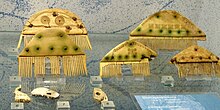Haßleben burial ground
Coordinates: 51 ° 7 ′ 0 ″ N , 11 ° 0 ′ 0 ″ E
| Haßleben burial ground | ||
|---|---|---|
| location | Thuringia , Germany | |
| Location | Hate life | |
|
|
||
| When | Younger Roman Empire , 3rd century AD |
|
| Where | Haßleben , near Erfurt / Thuringia | |
| displayed |
Museum for Prehistory and Early History of Thuringia in Weimar, Roman Empire |
|
The Germanic burial ground of Haßleben was discovered about 15 kilometers north of Erfurt in Haßleben . It is considered the most important burial ground of the younger Roman Empire in Thuringia . Excavations were carried out in 1911-1913 and again in the 1930s.
Find history
Armin Möller , curator at the Städtisches Museum in Weimar , examined some Elbe Germanic body graves at the gravel pit in Haßleben, a small town north of Erfurt, between 1911 and 1913 .
In 1913 a grave was discovered at the site that exceeded all previous findings from prehistoric graves in the Thuringia area. The uncovered extremely rich body grave of a woman of the Germanic elite was already noticeable by its size. An undisturbed, not robbed elite grave was discovered for the first time in situ in the Thuringian Basin .
There were a total of 24 graves in the cemetery, all body graves with a regular north-south orientation. The sizes of the grave pits correspond to the rich furnishings. Elbe Germanic graves were mostly cremations, in Haßleben there were surprisingly body graves with additions typical of Elbe Germanic people.
Dating
The grave field is dated to the second half of the third century. The dating is secured by the Aurei finds in the elite graves Finding 4, Finding 8 and Finding 20 and the dating for Haarhausen in the period after the Limes fall .
Find description
The small body grave field of a Germanic elite around the elite grave of the Princess von Haßleben was a so-called aristocratic burial place with 24 members of her followers. Some body burials reveal extraordinary wealth; few of the graves are simple burials.
The grave goods show that the elite of the Haßleben group or the early Old Thuringians - traditional research views them as Hermunduren - oriented themselves towards Roman culture and partly incorporated this into their own standard of living.
"Princess of Haßleben" (finding 8)
The elite grave (finding 8) contained the extraordinarily rich burial of a woman of the Elbe Germanic elite of the 3rd century AD. Her valuable jewelry was preserved: a gold, richly decorated choker, a glass bead necklace, an amber chain and other jewelry made of gold and Silver. The woman carried a Roman gold coin in her mouth, probably the Charon penny for admission into the realm of the dead . The crockery equipment was also elaborate. Imported goods from Rome made up the largest share of tableware . When it comes to ceramics, turntable goods predominate; a mortar is the only evidence of a Roman mortarium in a Germanic grave in Germania magna .
Elite grave (finding 21)
The second very rich grave (finding 21) - the burial in a grave pit three times a meter and 2.10 meters deep with jewelry and crockery made of gold and silver and also turntable goods - was located south of the elite grave of the 'Princess' in another group of elite graves . In addition to Elbe Germanic grave goods, Roman imports also occurred here .
More graves
The other graves also include five findings with golden finger rings, pendants and coins; the other grave goods of the findings are not comparable with those in finding no. 8 or in finding no. Three of the graves stand out for their silver additions.
The simple burials contain an additive made of bronze or a comb or even just ceramic additions. Turntables predominate in the ceramics of the burial ground. Five graves were without find.
interpretation
The Haßleben cemetery differs from the other cemeteries of the third century. Body graves, mainly jewelry and crockery made of gold and silver, Roman imports and turntable items as grave goods reveal an Elbe Germanic elite whose wealth and social relationships they emphasize within their community. The outdated interpretation as Burgundy belongs to the history of research. The assignment of these rich graves and the simultaneous body graves in the Thuringian Basin to the Hermunduren is also rejected by modern historical research . The Haßleben group or its sponsors in the Thuringia area can be seen as the early Old Thuringians, for whom the name “Thoringi” has been handed down at the end of the fourth century.
The different levels of equipment in the body graves of Haßleben were interpreted by Berthold Schmidt as two time horizons, Sigrid Dušek, on the other hand, joins Günter Behm-Blancke and sees here "representatives of the 'high nobility' with families and socially graded entourage" from the late Roman Empire the Germania magna . Wealth and Roman imports in the elite graves are explained with participation in trade or with the booty or pay for services in the Roman army, for example during the time of the Gallic Empire . Relations between Elbe Germans and Romans are documented by the written sources at this time. The social structure of outstanding elite graves in the Thuringian Basin and Middle Elbe Saale region corresponds to this historical tradition, but the associated princely seats have so far hardly been proven. The settlement finds of Haßleben, for example, do not justify an interpretation as a princely seat. The findings on turntable goods from Haßleben point to the production in an outstanding production facility like Haarhausen. It is assumed that this ceramics as well as the splendid fibulae from the princely grave (finding 8) and the elite grave (finding 21) were made by traveling craftsmen at the court of old Thuringian nobiles ("Edeling"). The elite graves of Haßleben only show parallels with princely graves such as Leuna , Stráže , Sakrau , Sanderumgard or Himlingøje .
exhibition
The outstanding findings and the princess grave, which stands out among the elite graves of the burial ground, are part of the permanent exhibition of the Museum of Prehistory and Early History of Thuringia in Weimar.
Remarks
- ↑ See Walther Schulz : The princely grave and the grave field of Haßleben . (= Roman-Germanic research 7). Mainz 1933.
- ↑ Cf. Sigrid Dušek : Roman craftsmen in Germanic Thuringia. Results of the excavations in Haarhausen, Arnstadt district . Stuttgart 1992; see. Sigrid Dušek: A Germanic fountain from Haarhausen, Ilm district . In: Excavations and finds in the Free State of Thuringia 1. 1996, pp. 19–24.
- ↑ See Hans Jürgen Eggers : The Roman import in free Germania (= Atlas of Prehistory. 1, ZDB -ID 533679-X ). Two volumes. Hamburg Museum of Ethnology and Prehistory, Hamburg 1951.
- ↑ Cf. Sigrid Dušek: Roman mortars in Germanic Thuringia . In: Alt-Thüringen 24. 1989, pp. 183-198.
- ↑ Cf. Arnim Möller : Fundnachrichten: Thüringen . In: Nachrichtenblatt für Deutsche Vorzeit 10. 1934, pp. 268–272.
- ↑ Cf. Wolfgang Schlüter : Attempt to differentiate the body grave group of Haßleben-Leuna from the Young Emperor on the basis of an analysis of the grave finds . In: New excavations and research in Lower Saxony 6. 1970, pp. 117–145.
- ↑ See Walther Schulz: The princely grave and the grave field of Haßleben . (= Roman-Germanic research 7). Mainz 1933.
- ↑ Cf. Berthold Schmidt : On the cultural structure of the Middle Elbe and Saale region during the late Roman imperial era and the early migration period . In: Prace Archaelogiczne 22. 1976, pp. 341-354.
- ^ Cf. Sigrid Dušek : Haßleben. In: Reallexikon der Germanischen Altertumskunde (RGA). 2nd Edition. Volume 14, Walter de Gruyter, Berlin / New York 1999, ISBN 3-11-016423-X , pp. 41–42 ( chargeable via GAO , De Gruyter Online).
- ↑ Cf. Günter Behm-Blancke : Society and Art of the Germanic Peoples . Berlin 1973.
- ↑ See Torsten Capelle , Otto-Herman Frey , Michael Fee , Heiko Steuer , Henrik Thrane: Fürstengräber. 4. Roman Empire .. In: Reallexikon der Germanischen Altertumskunde (RGA). 2nd Edition. Volume 10, Walter de Gruyter, Berlin / New York 1998, ISBN 3-11-015102-2 , pp. 168–220 ( chargeable via GAO , De Gruyter Online) .; see. Mario Becker : Gommern. In: Reallexikon der Germanischen Altertumskunde (RGA). 2nd Edition. Volume 12, Walter de Gruyter, Berlin / New York 1998, ISBN 3-11-016227-X , pp. 395–399 ( paid for via GAO , De Gruyter Online).
- ↑ See Hans Jürgen Eggers: The Roman import in free Germania (= Atlas of Prehistory. 1, ZDB -ID 533679-X ). 2 volumes. Hamburg Museum of Ethnology and Prehistory, Hamburg 1951.
- ↑ Cf. Joachim Werner : On the Roman mantle fibulae of two warrior graves from Leuna . In: Annual journal for Central Germans. Prehistory 72, 1989, pp. 121-134.)
- ↑ Cf. Sigrid Dušek : Roman craftsmen in Germanic Thuringia. Results of the excavations in Haarhausen, Arnstadt district . Stuttgart 1992.
literature
- Matthias Becker, Jan Bemmann , Rudolf Laser, Rosemarie Leineweber , Erika Schmidt-Thielbeer: Corpus of the Roman finds in the European Barbaricum. Germany . Volume 6: Saxony-Anhalt. Bonn 2006.
- Günter Behm-Blancke : Society and art of the Teutons . Berlin 1973.
- Torsten Capelle , Otto-Herman Frey , Michael Fee , Heiko Steuer , Henrik Thrane: Prince's Graves. In: Reallexikon der Germanischen Altertumskunde (RGA). 2nd Edition. Volume 10, Walter de Gruyter, Berlin / New York 1998, ISBN 3-11-015102-2 , pp. 168–220 ( chargeable via GAO , De Gruyter Online).
- Sigrid Dušek : Roman mortars in Germanic Thuringia . In: Alt-Thüringen 24. 1989, pp. 183-198.
- Sigrid Dušek: Roman craftsmen in Germanic Thuringia. Results of the excavations in Haarhausen, Arnstadt district . Stuttgart 1992.
- Sigrid Dušek: A Germanic fountain from Haarhausen, Ilm district . In: Excavations and finds in the Free State of Thuringia 1. 1996, pp. 19–24.
- Hans Jürgen Eggers : The Roman import in free Germania (= Atlas of prehistory. 1, ZDB -ID 533679-X ). 2 volumes. Hamburg Museum of Ethnology and Prehistory, Hamburg 1951.
- Arnim Möller : Found news: Thuringia . In: Nachrichtenblatt für Deutsche Vorzeit 10. 1934, pp. 268–272.
- Wolfgang Schlueter : Attempt to differentiate the body grave group from Haßleben-Leuna from the early days of the imperial era based on an analysis of the grave finds . In: New excavations and research in Lower Saxony 6. 1970, pp. 117–145.
- Berthold Schmidt : On the cultural structure of the Middle Elbe and Saale region during the late Roman imperial period and the early migration period . In: Prace Archaelogiczne 22. 1976, pp. 341-354.
- Walther Schulz : The princely grave and the grave field of Haßleben . (= Roman-Germanic research 7). Mainz 1933.
- Joachim Werner : On the Roman cloak fibulae of two warrior graves in Leuna . In: Annual journal for Central Germans. Prehistory 72, 1989, pp. 121-134.


